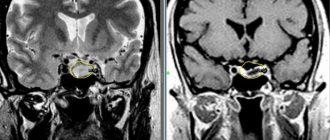Lobotomy is a surgical method of treating mental illnesses, the meaning of which is to disconnect or destroy the connections of one of the parts of the brain of the head with the rest of its parts. As a rule, the concept of “lobotomy” implies the separation of any of the frontal parts from the rest of the brain. This is a neurosurgical operation that is not currently used, that is, it is already history.
This method of treatment was developed in those years when there were no effective medications that could be used to cure schizophrenia, mental behavior disorders with hallucinations and delusions, when psychiatric patients were a significant threat to the lives of other people. After the creation of Aminazine (a drug of the neuroleptic class), lobotomy became an unpopular method of treatment. But there are a lot of creepy stories and legends around this concept, which are still retold in our time. What kind of terrible method of treatment is this, who created it and used it for the first time, what consequences this operation had, you will find out by reading this article.
The history of lobotomy
The founder of this type of surgical intervention is Dr. Egas Moniz (Moniz) from Portugal. In 1934, at a meeting of neurologists, he became very interested in one of the experiments of his colleagues, who cut out the frontal part of a rather irritable and aggressive monkey named Becky. As a result of the removal of this brain part, the monkey became controlled and quiet.
Egash suggested conducting this experiment on humans. It’s just that at that time there were no effective medications that could cope with the aggression and agitation of mentally ill patients. These people were isolated in psychiatric hospitals, put in restraint jackets (which was not always safe for medical workers), and placed in empty rooms with soft padding on the walls so that patients could not harm others or themselves.
Summing up
Psychiatry today is not that different from psychiatry a century ago. Yes, patients are not tortured, the level of service and hygiene has increased significantly, instead of surgical operations, patients take pills. But the percentage of those recovering is as pitifully small as it was a century, two, or three ago. Even the most modern means can suppress the disease, hide its symptoms, but not cure the person completely. And there are so many side effects of medications that you can’t list them.
Therefore, you shouldn’t point to the past and say: what a horror! How could they do that! How they mocked the poor mentally ill! The fact is that life is not sweet for them even now. It’s just that every era has its own hell.
Source
What is a lobotomy: general concepts
By and large, no treatment was carried out as such; patients were “closed” in mental hospitals, from where it was almost impossible to return to a full life. Therefore, doctors struggled to develop an effective way to treat these people. And so Egas Moniz proposed to disrupt one of the frontal parts of the human brain, since it is the frontal parts that are responsible for the mental adequacy of people’s behavior.
Some time after the congress of doctors in 1936, under the leadership of Egas, surgeon Almeida Lima performed a human lobotomy, the first in the world. Two holes were drilled into the skull of a woman who suffered from paranoia, through which alcohol was injected, which destroyed part of the brain in the frontal region. The operation was called leucotomy (translated from Greek λευκός - white, since the substance of the brain of the head is white when cut, and τομή - cut). That is, nothing was removed from the cranial cavity. The patient's condition improved and, inspired by the success, doctors began to introduce this method of treatment.
Subsequently, Egas Moniz improved this operation. A special surgical instrument was developed - a leukotome , which cut brain tissue with a wire loop. Of the 20 people who were subjected to lobotomy, 7 began to feel better, another 7 had an insignificant result, and 6 had no effect at all. The less than positive results did not stop Egash from continuing to use this method of treatment, and in 1949 he was even awarded the Nobel Prize for his contribution to the treatment of complex mental disorders.
Moniz's idea was very quickly and actively picked up in the USA. Neurosurgeon James Watts and psychiatrist and neurologist Walter Freeman began performing lobotomies, which also required drilling holes in the skull and, accordingly, was not available to most psychiatric clinics (since this required a special doctor, a neurosurgeon).
Freeman set himself the task of simplifying lobotomy so much that every psychiatrist could perform this operation independently. And after some time, he proposed an operation called transorbital lobotomy.
Definition
Lobotomy is a psychosurgical operation, the task of which is to change the functioning of the frontal or other lobes of the brain, including those responsible for self-determination and self-awareness of a person, through surgical intervention. In this case, either the connections between adjacent lobes are interrupted, or the white medulla is removed, due to which the operation received an alternative name - leucotomy. To do this, a special tool is used - a leukotome, which resembles a small knife for chopping ice.
There were several types of lobotomy. For example, when performing an operation such as a transorbital lobotomy, the doctor inserted an instrument into the patient's eye socket, thus reaching the desired areas of the brain, and then cutting them. In prefrontal lobotomy, holes are drilled or punched into the patient's skull to interfere with the brain. This is a rather scary operation, but some patients who underwent such an intervention experienced an improvement in their psychological state, however, such cases were few.
What is transorbital lobotomy?
This surgical intervention was performed without drilling holes in the skull. The brain of the head was accessed using the orbit .
- After treating the skin with an anesthetic, a section of skin was cut above the eye.
- The surgical instrument, resembling an ice pick, was inserted into the orbital area.
- The blows were made with a special hammer, a thin layer of bone was broken through in the area of the eye socket, the knife was inserted into the brain at an angle of 15-20 degrees relative to the vertical, and with one movement the nerve endings that connected the frontal part with other parts of the brain of the head were cut.
- The knife was taken out, a probe was installed to remove destroyed cells and blood, and the wound was sutured.
Since the brain tissue of the head is not sensitive to pain, Walter Freeman proposed performing this intervention without anesthesia, under electric shock , in order to bring the whole procedure even closer to ordinary mental hospitals.
As time passed, Walter Freeman performed lobotomies one after another, very quickly the number of operations reached 3,500 people. Walter talked about the “positive” effect of these operations, but did not go into much detail. But in reality the results were not so encouraging. Most of the patients, although they became less aggressive, lost their mental capabilities, fell into a stupor, and began to urinate on themselves.
Freeman directly called these phenomena surgically reproduced childhood , believing that it is in this way that the human brain moves to a younger mental time. He probably thought that in the future all the lost skills would be developed again, and “growing up” would happen again. It was for this reason that he suggested treating these patients like naughty children. But, unfortunately, the lost skills were not restored again; most people remained crippled for the rest of their lives.
Nowadays, doctors are required to first inform the patient about what will be done, how great the risk is and possible complications , and only then carry out complex mental or physical treatment. The sick person must understand the risk, make the appropriate decision and sign the necessary papers. However, in the days of lobotomy, sick people did not have these rights, and informed consent was not treated very carefully. Essentially, doctors could do whatever they wanted.
Freeman said that a mentally ill person cannot consent to a lobotomy because he is not able to understand the full benefits of it. But the doctor simply did not give up. If he was unable to obtain consent from the patient, he turned to his relatives in the hope that they would give consent. What is much worse, when the patient had already agreed, but at the last second changed his mind, the doctor still performed the operation, even when it was necessary to “turn off” the person.
In most cases, the patient had to agree to undergo an operation against his will: surgeons or family members decided for the patients, who probably did not want to harm, but were irresponsible in their treatment.
Development of the concept of surgical interventions
Monitz's ideas also interested other doctors around the world. In the United States, the first lobotomy was performed by Walter Freeman and James Watts. But, unlike Monitz, their methodology was different. The entire intervention was limited to inserting an “ice pick” through the patient’s eye socket into the brain, after which the frontal lobe was cut with one movement of the instrument. It was this method of intervention that later became known as transorbital lobotomy. To increase the effectiveness, anesthesia during surgery was administered using electric shock. And, like Monitz, his American colleagues announced the successful completion of the experiment. In total, about 3,500 operations were performed.
Consequences after a lobotomy
We can safely say that there have been very rare cases when a lobotomy treated a mental illness, without causing harm to a person’s health. Most often, many of the results of a lobotomy were quite disastrous . What complications appeared after performing a lobotomy? Let's consider:
- epileptic seizures;
- infectious complications (encephalitis, meningitis);
- muscle weakness in the limbs (paralysis and paresis);
- violations of control over the work of the pelvic organs (defecation and urination);
- speech disorders;
- loss of sensation;
- death (up to 6% of total cases);
- rapid increase in human weight;
- emotional dullness, a significant decrease in intelligence (patients after surgery were called “vegetables” and compared to domestic animals).
As you can see, not all the time the elimination of mental disorders using a lobotomy could be compared with other “effects” of these operations. And, by and large, lobotomy did not always cure psychiatric diseases. Taking into account statistics, for one third of the people operated on, the operation was useless , for another third it was accompanied by significant complications, and only another third of patients received a certain therapeutic result.
Vicious fragile connections
It was assumed that if the frontal lobe was removed or separated from the rest of the brain, it would help get rid of aggression and reduce the symptoms of mental disorders. In those years, the nervous system was not studied enough to diagnose disorders and evaluate what happens after such an intervention.
Another similar operation to cross nerve pathways was also practiced - leucotomy or prefrontal lobotomy of the brain. Its difference from a lobotomy is in how it is done - during this manipulation, the nerve pathways lying in the white matter of the brain were crossed. That is, the nerve fibers of the limbic system, which is responsible for the emotional state and behavior. After such an intervention, patients behaved noticeably calmer, but remained crippled for the rest of their lives. They lost self-control and their intelligence deteriorated. As a result, they could not exist independently.
At first, lobotomy was prescribed to almost hopeless patients; specific indications for lobotomy were not determined. However, due to the ease of implementation (it was not even performed by surgeons) and immediate results, it gained popularity and began to be carried out under various pretexts and for those who had no need for psychiatric help at all.
When was the lobotomy operation cancelled?
Not all neurosurgeons supported this method of treatment. Very often thoughts were expressed about the increased traumatic nature of these procedures and the inappropriateness of this method of treatment. Relatives of patients to whom the operated patients were returned in a state of “vegetables” began to write complaints and petitions so that this inhumane method of treatment would be banned.
The only thing on which most doctors agreed was that lobotomy could only be used in situations where none of the treatment methods existing at that time (including electric shock, insulin therapy) showed any positive effect, and the person was very aggressive and could cause harm to others or yourself.
But at the same time, lobotomy gradually began to gain momentum and was performed even in the most banal situations . For example, one child was lobotomized at the age of 12 due to his bad behavior and disobedience. And this is not just one example. The abuse of such a surgical method of therapy as lobotomy, unfortunately, has been noted more than once.
The decline of lobotomy dates back to the 1950s. In the Soviet Union, after studying the effectiveness of lobotomy treatment on 400 patients in 1950, the Ministry of Health issued a decree officially banning this method of treatment. In some countries, such as Norway, America, France, England, India, Belgium, Spain, Finland and some others, lobotomy was performed until the 80s of the 20th century. There is no exact date for the ban on these terrible operations.
After investigating some cases of lobotomy, in 1977 the National Committee for the Protection of Human Subjects from Behavioral and Biomedical Research concluded that only in some situations this operation is justified, and, by and large, it is absolutely ineffective . And over time, this treatment fell into oblivion. An important role in this was played by the fact that in 1950 the antipsychotic Chlorpromazine (Aminazine) was created for the first time in the world. When it began to be used in psychiatric practice, it became a major breakthrough in treatment. And after this, there was no longer a need for a lobotomy, since it was now possible to reduce the phenomena of psychosis with the help of ordinary injections.
How Nellie Bly exposed mental hospitals
In 1887, 23-year-old journalist Nellie Bly quit her job at the Pittsburgh Dispatch, tired of covering theater premieres, and figured out how to make a report that could bring her real fame and recognition. Of course, she was guided not only and not so much by egoism. First of all, she was motivated by philanthropy.
In just one night, Nellie rehearsed - her theatrical experience helped her - the behavior of a schizophrenic, and the next day she rented a room in a cheap house for workers. All day long she drove the owners of the house to white heat, running to them from her room and reporting either about giant rats or about monsters in the closet, and calling them crazy killers. Quite quickly, Nellie was considered crazy, the police were called, and a few days later, after an examination that confirmed her insanity, the girl ended up in the New York psychiatric hospital Bellevue.
Nellie Bly trains to feign madness
Nellie Bly is examined by a psychiatrist (drawing from the first edition of the book “Ten Days in a Madhouse”)
Bly spent ten days in the hospital and was amazed at the unsanitary, anti-scientific, inhumane conditions in which the patients were kept. For most of the day - from six in the morning to eight in the evening - the patients were tied up, sitting on wooden benches, and they were not given any protection from the cold. They were fed spoiled beef and stale bread rejected by farms, and they were given dirty water to drink. Patients were not allowed to go to the toilet at odd hours, they constantly defecated on themselves, and no one cleaned it up. The hospital was full of rats. The patients did not receive any treatment other than blows with sticks. They washed them by dousing them with ice water.
The Octagon on Roosevelt Island is the main entrance to the very hospital where Nellie Bly spent ten days. Photo from 1897
Ten days later, Nellie was taken from the hospital by employees of The World newspaper, with whom she had agreed in advance to prepare the material. Her report did not fit into the length of the article and was published separately in the form of a book, “Ten Days in a Madhouse.” The publication became a sensation; In the same year, 1887, a trial was held, police were sent to the hospital, and Nellie Bly became the main witness in the case of abuse of patients.
This was a turning point. After the end of the scandal, which resulted in many heads rolling - the investigation affected a number of mental hospitals - significantly more funds began to be allocated to psychiatry, hospitals began to be inspected, and methods of “cure” began to change rapidly. In essence, Nellie initiated a revolution, a transition from medieval “medicine” to modern one, and paved the border between two eras.
Well, let's see what happened “before”, what it turned into “after” and how things are now.
Modern methods of treatment
Neurosurgical methods for treating mental disorders were not limited to just lobotomy. After the ban on this cruel method of treatment, more gentle ones were developed , for example:
- limbic leucotomy;
- capsulotomy;
- anterior cingulotomy.
The meaning of which is a partial disruption of clearly defined parts of the brain. But these methods are resorted to only in cases of stable, resistant types of mental disorders, if no other modern methods of treatment have any effect at all.
That is, to summarize all of the above, we can say that lobotomy is a rather barbaric method of treating mental illness, which today is already history. Destruction of parts of the brain with instruments just to normalize the mental state has not been done for a long time. Science has found much more effective and humane ways to treat mental disorders.










